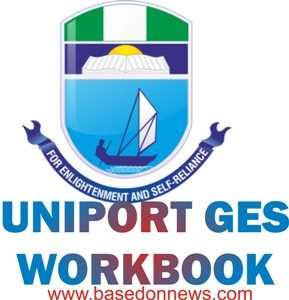UNIPORT GES 104 – Answers to GES 104 – History and Philosophy of Science Workbook Part II

Uniport GES 104 – This post is majorly for all the students that want to fill UNIPORT GES 104 – History and Philosophy of Science Workbook. This article will help you to confirm the answers you wish to select or you’ve selected. Also, guidelines on how you will write your GES 104 exams and possible questions you will see are also stated. GES 104 has been initiated as a compulsory course by NUC to all departments in the University of Port Harcourt and even to other schools at large. It is a course where you are been taught the History and Philosophy of Science. This is where students who may not major in Science are opportune to have knowledge of it. It is indeed a cultural heritage. Uniport does not play with GES courses as it is very compulsory that all students must pass it before graduating from the University.
Many have failed the course just because they were not informed or they were not updated with the right information. Always visit the site, www.basedonnews.com to get updates and similar questions that would come out in your exam. We have been doing it; that is helping students with the right information. We still believe we can.
As we promise to always keep you updated with tips on how to be successful in your academics, latest scholarships, assignments, current questions, and questions you are likely to see in your exams. To be always updated with recent information and get it directly to your phone, kindly subscribe to us using your Email address. Subscription is totally free. You can also Like our Facebook Page and Follow us on Twitter to always get updates in your phone via social media.
FOR GES 103 PART I – CLICK HERE
FOR GES 104 PART I – CLICK HERE
This GES 104 Part II is typically done to assist students in answering the questions from Question 31 to Question 70. If you’ve answered yours and want to confirm if what you’ve done is correct, you can easily check the answers below. If you’ve not answered any, you can still use this as a guideline to answer yours. But in all, we advise you read the Textbook so that you can confirm the answers provided.
Answers to 100 GES 104 Questions
- Which of the following is not an example of organic acids _____ Answer: (d) Chromic acid
- Which of these is an example of flammable liquids _____ Answer: (b) heat
- An example of a flammable solid is _____ Answer: (c) wood/paper
- An air sensitive compound is _____ Answer: (d) Propane
- Chemical toxicity can be prevented or controlled by which of these methods _____ Answer: (a) wearing appropriate personal protective equipment for the compound
- The acronym HLW means _____ Answer: (c) High Level Waste
- The acronym, NORM means _____ Answer: (b) Naturally Occurring Radioactive Material
- BCE stands for what? _____ Answer: (d) Before the Christian Era
- Who is the father of modern physics _____ Answer: (c) Galileo
- Who formulated the theory of Earthquakes _____ Answer: (b) Robert Hooke
- Resources which are formed over long ecological periods are called _____ Answer: (b) Non-renewable resources
- Which of the following is very important to all life and is indispensable _____ Answer: (c) Oxygen
- Example of irreplaceable natural resources includes all except _____ Answer: (a) forest
- Based on vegetation, land can be divided into the following except _____ Answer: (d) basement
- Which of the following is a threat to wildlife _____ Answer: (b) habitat fragmentation/destruction
- Which of these describes the management of resources for continuous production aimed at achieving approximately a balance between the net growth and the harvest _____ Answer: (c) sustainable use
- The three major component of resource management includes the following except _____ Answer: (d) ecosystem sustainability
- Which of these is not a renewable resource _____ Answer: (d) uranium
- Which energy converts sunlight directly to electricity _____ Answer: (b) solar energy
- All these are non-living things except _____ Answer: (d) fish
- Who proposed the theory of continental drift _____ Answer: (a) Alfred Wegner
- Who is the real founder of science of Biology _____ Answer: (c) Aristotle
- All of these contributed to the quantum theories except _____ Answer: (c) Niels Bohr
- The father of modern chemistry is _____ Answer: (d) Robert Boyle
- Which parts of the body is frequently exposed body tissue to poisons _____ Answer: (a) Skin
- Any substance, radionuclide or radiation that is an agent directly involved in the promotion of cancer or in the facilitation of its propagation is called _____ Answer: (c) Carcinogen
- A substance that ignites spontaneously with autoignition temperature less than 450C is called _____ Answer: (c) Pyrophoric materials
- All are examples of corrosive gaseous emissions except _____ Answer: (d) oxygen
- The major common element includes all except _____ Answer: (b) sulphur
- Any material that opposes the flow of electric current is called _____ Answer: (b) an insulator
- The concept that deals with usage and knowledge of tools and crafts is called _____ Answer: (b) technology
- The logical and rational order or steps by which scientist come to conclusions about the world around them is termed _____ Answer: (b) scientific method
- The following are types of waste except _____ Answer: (c) sustainable waste
- CFCs were discovered in the 1930s by an American Chemist called _____ Answer: (d) Thomas Midgley
- Global warming is called the greenhouse effect because _____ Answer: (a) the gases that are gathering above the earth make the planet comparable to a greenhouse
- The following are air pollutants except _____ Answer: (d) manganese
- The largest environmental problems now affecting the world due to man’s activities includes all except _____ Answer: (b) smuggling and human trafficking
- The resistance of a mineral to breakage is called _____ Answer: (b) tenancy
- The ratio between the mass of a mineral and that of an equal volume of water is called _____ Answer: (a) specific gravity
- The minor constituents of the atmosphere includes the following except _____ Answer: (c) oxygen
If what we are doing is really Okay by you, please comment below.
TO GET THE REMAINING PART OF THE GES WORKBOOK, CLICK HERE
For possible questions you will see in your Exam Call Click Here
We advise you read the Textbook as Exam questions will come out from the Textbook as well as the workbook.
Are you having any challenge in any course?
Do you have any question that is bothering you?
Are you in need of scholarship for financial release?
Kindly comment below for assistance.
Also communicate WITH US if there is any problem.
UNIPORT GES 104 – Answers to GES 104 – History and Philosophy of Science Workbook Part II

Thanks. It’s really helpful.
Thanks, keep it up
Okay
God bless